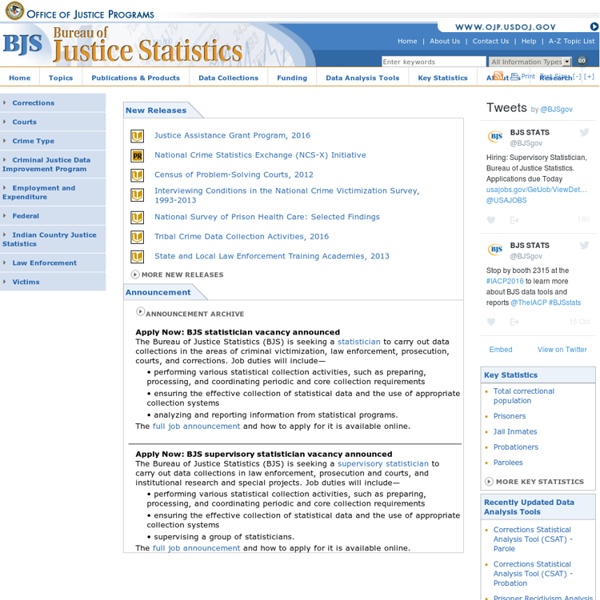Bureau of Justice Statistics (BJS)
Corrections Statistical Analysis Tool (CSAT) - Prisoners has been updated with 2012 data. This dynamic analysis tool allows BJS web users to examine National Prisoner Statistics (NPS) data on prisoners under the jurisdiction of both federal and state correctional authorities. Users can instantly generate tables of numbers and rates of national and jurisdictional statistics, from 1978 to the most recent year that NPS data are available. The web tool includes national and state-level data from the 50 state departments of correction and from the District of Columbia (until 2001, when the District ceased operating a prison system). The web tool’s pre-set quick tables show trends in prisoner statistics and provide links to key tables in the most recent BJS publication.
http://www.bjs.gov/
U.S. Bureau of Economic Analysis (BEA)
Lawyers, Guns & Money
UCR Program Adds Human Trafficking Offenses to Data Collection, Includes More Specific Prostitution Offenses
On January 1, 2013, the FBI’s Uniform Crime Reporting (UCR) Program began collecting data regarding human trafficking as mandated by the William Wilberforce Trafficking Victims Protection Reauthorization Act of 2008. According to David Cuthbertson, assistant director of the FBI’s Criminal Justice Information Services (CJIS) Division, “As law enforcement begins to capture and submit data on human trafficking, our UCR statistics will start to show the extent of what is essentially modern-day slavery in our country.” Now, law enforcement agencies participating in the UCR Program can submit offense and arrest data for human trafficking in two new categories: commercial sex acts and involuntary servitude. The UCR Program defines these offenses as follows: Human trafficking/commercial sex acts—Inducing a person by force, fraud, or coercion to participate in commercial sex acts, or in which the person induced to perform such act(s) has not attained 18 years of age.
Energy Information Administration, EIA
Journal d'un avocat
How to Report New UCR Initiatives
NIBRS Agencies Use Revised Flat File Layouts One document now supplies NIBRS agencies with everything they need to submit all of the new types of data. The NIBRS Technical Specification provides updated flat file record layouts (including the cargo theft indicator), new offense definitions (for trafficking offenses), and additional data values (for new bias motivation categories and types, as well as updated race and ethnicity categories). This document is available on the FBI’s updated website at
U.S. Anti-Trafficking Legislation » The Protection Project
The Trafficking Victims Protection Act (TVPA) enacted in 2000, and subsequently reauthorized in 2003, 2005, 2008, and 2013 is the main U.S. federal legal instrument to address trafficking in persons. Using the “3 P” approach, the TVPA provides for - prosecution of perpetrators of trafficking in persons by establishing the crimes of trafficking in persons and listing the punishments,protection of victims of trafficking by creating a bill of rights for victims, including the right to medical care, shelter, restitution, civil remedy, residency status, work permit, access to information, andprevention of trafficking by allowing for programs and grants to increase awareness on human trafficking. The TVPA addresses both trafficking for the purpose of sexual exploitation and labor exploitation. Definition of “severe forms of trafficking in persons” in Section 108 (3) of the TVPA: The TVPA in 5 Colors:
Trafficking Maps
Trafficking Maps Human trafficking occurs all over the world. In North America, there are over a dozen major trafficking hubs. This means that people, primarily girls and women, are brought from all over the world—by boat, airplane or car. The traffickers use false passports and paperwork so that the origin and identities of the girls are concealed or lost.
Related:
Related:



